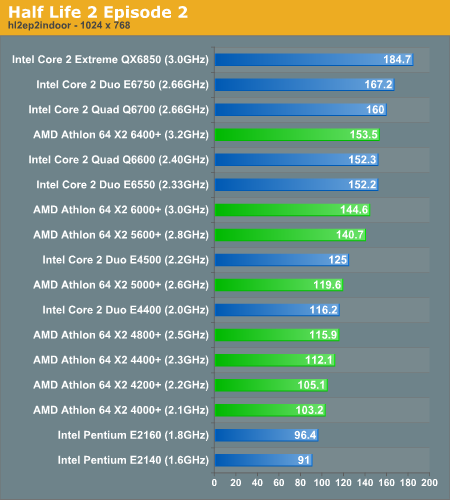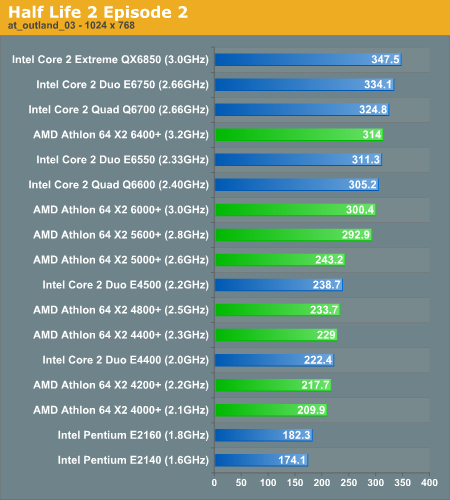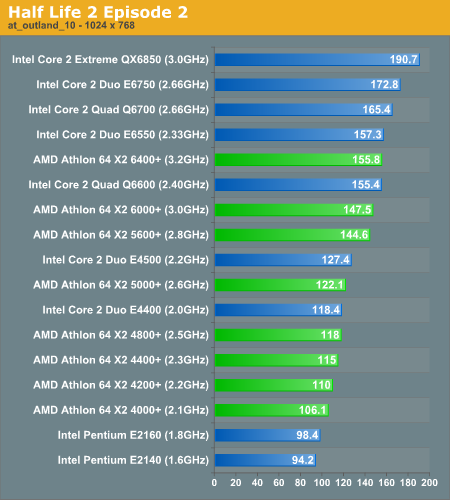UPDATED Half-Life 2: Episode 2 CPU and Graphics Performance
by Anand Lal Shimpi & Derek Wilson on October 12, 2007 7:00 AM EST- Posted in
- GPUs
The Benchmarks
We ran all of our tests on the following system configurations:
We'll start off with a look at CPU performance. For these tests we ran at 1024 x 768 to minimize any GPU bottlenecks and highlight differences between CPUs.
CPU Performance
Our first benchmark is of an indoor map with a reasonable sized firefight taking place. The frame rates are high due to the indoor environment but the explosions and computer interaction keep our CPUs busy doing more than just feeding data to the GPU.

Intel continues to hold onto the overall performance crown as AMD has nothing faster than the Athlon 64 X2 6400+, but the race is a bit closer at lower price points.
The limited production 6400+, albeit more expensive than Intel's Core 2 Duo E6750, ends up underperforming its closest competitor. The Core 2 Duo E6550 is about 5% faster than the Athlon 64 X2 6000+, but honestly the performance advantage isn't large enough to really matter, especially in more realistic GPU-bound scenarios.
The Core 2 Duo E4000 series ends up losing a bit of ground to AMD thanks to having a smaller L2 cache and slower FSB, both of which Episode 2 is particularly sensitive to. The Athlon 64 X2 5600+ is 12% faster than its price-competitor, the Core 2 Duo E4500. It's interesting to note the impact of L2 cache size on performance even in the AMD camp; the Athlon 64 X2 5000+ only has a 512KB L2 per core (vs. 1MB of the 5600+) and performance drops significantly, to the point where it's a toss up between the 5000+ and the Core 2 E4400.
At the low end of the spectrum, Half Life 2's dependency on very fast memory accesses and large cache sizes really penalize the Pentium Dual-Core processors, both of which are bested by their AMD rivals. AMD's margin of victory isn't tremendous but it's clear that Intel's lack of an on-die memory controller does hinder gaming performance of these small-cache parts.
Look at real world performance however, even the difference between an Athlon 64 X2 4200+ and a Pentium E2160 will be largely masked by GPU limitations at higher resolutions.
Our next benchmark takes place in the outland_03 level, in a small indoor environment resulting in ridiculously high frame rates for all of the CPUs. The performance comparison in this benchmark is almost purely academic, simply highlighting differences between microprocessors as even the cheapest CPUs in this comparison pull over 170 fps in this test.

Half Life 2 Episode 2 continues to be very sensitive to FSB frequency, which is part of the reason why we see the dual core E6750 (1333MHz FSB) pull ahead of the quad core Q6700 (1066MHz FSB). There's slight overhead associated with running HL2 on a quad-core system, which doesn't make for a better situation, not to mention that the game doesn't take advantage of more than two threads. Quad-core owners won't really be plagued by lower performance than their dual core compatriots, but they simply don't get any benefit out of the latest version of Valve's Source engine. The standings remain relatively unchanged, once more we see that L2 cache size and latency strongly impact performance. The 90nm Athlon 64 X2 5600+ features a 1MB L2 cache per core with a slightly lower access latency than the 65nm Athlon 65 X2 5000+, with its 512KB L2 per core, the resulting performance difference is significant; the 5600+ holds onto a 20% performance advantage over the 5000+, despite only a 7.6% increase in clock speed.
Intel's Core 2 lineup gets hurt even worse as you look at the 800MHz FSB/2MB L2 E4000 parts. The E4500 is seriously outperformed by the 5600+ and ends up being equal to the 5000+, despite the latter being priced lower.
The Pentium Dual-Core processors pull up the rear once more, thanks to even lower clock speeds and meager 1MB L2 caches shared between two cores.
Our final performance test takes place in the outland_10 map, an outdoor environment where we spend most of our time driving around (poorly) and avoiding the topography of the level.

The standings remain unchanged: Intel holds the overall performance crown, the two are competitive at $150 - $200 price points, and AMD manages to pull ahead in the sub $150 market.
We ran all of our tests on the following system configurations:
| Test Setup | |
| CPU | Core 2 Duo E6550 (2.33GHz 4MB 1333FSB) Core 2 Duo E4500 (2.2GHz 2MB 800FSB) Core 2 Duo E4400 (2.0GHz 2MB 800FSB) Pentium E2160 (1.8GHz 1MB 800FSB) Pentium E2140 (1.6GHz 1MB 800FSB) AMD Athlon X2 5000+ (2.6GHz 2x512K) AMD Athlon X2 4800+ (2.5GHz 2x512K) AMD Athlon X2 4200+ (2.2GHz 2x512K) AMD Athlon X2 4000+ (2.1GHz 2x512K) |
| Motherboard | Intel: ASUS P5K-V G33 AMD: Biostar TF-7050M2 |
| Video Cards | AMD Radeon HD 2900 XT AMD Radeon HD 2600 XT AMD Radeon HD 2600 Pro AMD Radeon HD 2400 XT NVIDIA GeForce 8800 Ultra NVIDIA GeForce 8800 GTX NVIDIA GeForce 8800 GTS 320MB NVIDIA GeForce 8600 GTS NVIDIA GeForce 8600 GT |
| Video Drivers | AMD: Catalyst 7.10 NVIDIA: 163.69 |
| Hard Drive | Seagate 7200.9 300GB 8MB 7200RPM |
| RAM | 2x1GB Corsair XMS2 PC2-6400 4-4-4-12 |
| Operating System | Windows Vista Ultimate 32-bit |
We'll start off with a look at CPU performance. For these tests we ran at 1024 x 768 to minimize any GPU bottlenecks and highlight differences between CPUs.
CPU Performance
Our first benchmark is of an indoor map with a reasonable sized firefight taking place. The frame rates are high due to the indoor environment but the explosions and computer interaction keep our CPUs busy doing more than just feeding data to the GPU.

Intel continues to hold onto the overall performance crown as AMD has nothing faster than the Athlon 64 X2 6400+, but the race is a bit closer at lower price points.
The limited production 6400+, albeit more expensive than Intel's Core 2 Duo E6750, ends up underperforming its closest competitor. The Core 2 Duo E6550 is about 5% faster than the Athlon 64 X2 6000+, but honestly the performance advantage isn't large enough to really matter, especially in more realistic GPU-bound scenarios.
The Core 2 Duo E4000 series ends up losing a bit of ground to AMD thanks to having a smaller L2 cache and slower FSB, both of which Episode 2 is particularly sensitive to. The Athlon 64 X2 5600+ is 12% faster than its price-competitor, the Core 2 Duo E4500. It's interesting to note the impact of L2 cache size on performance even in the AMD camp; the Athlon 64 X2 5000+ only has a 512KB L2 per core (vs. 1MB of the 5600+) and performance drops significantly, to the point where it's a toss up between the 5000+ and the Core 2 E4400.
At the low end of the spectrum, Half Life 2's dependency on very fast memory accesses and large cache sizes really penalize the Pentium Dual-Core processors, both of which are bested by their AMD rivals. AMD's margin of victory isn't tremendous but it's clear that Intel's lack of an on-die memory controller does hinder gaming performance of these small-cache parts.
Look at real world performance however, even the difference between an Athlon 64 X2 4200+ and a Pentium E2160 will be largely masked by GPU limitations at higher resolutions.
Our next benchmark takes place in the outland_03 level, in a small indoor environment resulting in ridiculously high frame rates for all of the CPUs. The performance comparison in this benchmark is almost purely academic, simply highlighting differences between microprocessors as even the cheapest CPUs in this comparison pull over 170 fps in this test.

Half Life 2 Episode 2 continues to be very sensitive to FSB frequency, which is part of the reason why we see the dual core E6750 (1333MHz FSB) pull ahead of the quad core Q6700 (1066MHz FSB). There's slight overhead associated with running HL2 on a quad-core system, which doesn't make for a better situation, not to mention that the game doesn't take advantage of more than two threads. Quad-core owners won't really be plagued by lower performance than their dual core compatriots, but they simply don't get any benefit out of the latest version of Valve's Source engine. The standings remain relatively unchanged, once more we see that L2 cache size and latency strongly impact performance. The 90nm Athlon 64 X2 5600+ features a 1MB L2 cache per core with a slightly lower access latency than the 65nm Athlon 65 X2 5000+, with its 512KB L2 per core, the resulting performance difference is significant; the 5600+ holds onto a 20% performance advantage over the 5000+, despite only a 7.6% increase in clock speed.
Intel's Core 2 lineup gets hurt even worse as you look at the 800MHz FSB/2MB L2 E4000 parts. The E4500 is seriously outperformed by the 5600+ and ends up being equal to the 5000+, despite the latter being priced lower.
The Pentium Dual-Core processors pull up the rear once more, thanks to even lower clock speeds and meager 1MB L2 caches shared between two cores.
Our final performance test takes place in the outland_10 map, an outdoor environment where we spend most of our time driving around (poorly) and avoiding the topography of the level.

The standings remain unchanged: Intel holds the overall performance crown, the two are competitive at $150 - $200 price points, and AMD manages to pull ahead in the sub $150 market.










46 Comments
View All Comments
tonjohn - Friday, October 12, 2007 - link
I would also like to see tests on:* 1gb vs 2gb vs 4gb of ram
* WinXP vs Vista (maybe even 32bit vs 64bit OS comparisons)
* EP1 performance vs EP2 performace & CSS (or DODS) performancs VS TF2 performance.
tonjohn - Friday, October 12, 2007 - link
This article claims that the new engine only takes advantage of two cores. However, Valve's comments all suggest that the engine can take advantage of four or more cores.As for proof, this is what one of my co-workers from Valve's forums reports:
"How about this?!
http://i24.tinypic.com/rvefs6.png">http://i24.tinypic.com/rvefs6.png
I was in the level called "our mutual fiend" where you go down into the depths to find out what is going on. Multiple hunters and all kinds of activity going on. I'm going to run this same level with graphical settings all on low to eliminate GPU bottlenecks and set the core affinity for HL2 to use one, then two, then three and then four and record the fps in game."
ViRGE - Friday, October 12, 2007 - link
I could be wrong here, but that doesn't indicate that HL2 is using all 4 cores. It could be bouncing processes between cores (which does happen with other applications), which makes it look like all 4 cores are in use.tonjohn - Saturday, October 13, 2007 - link
Here is the official official word on this topic:So AnAnd needs to adjust the article.
tonjohn - Monday, October 15, 2007 - link
The article still says that the new engine only supports two threads when that is actually wrong. Please fix this.FrankThoughts - Saturday, October 13, 2007 - link
I have several thoughts.First, the whole "30FPS is too slow" stuff is garbage. Maybe in multiplayer, but in single player HL2 Episode Two is perfectly good at 30-40 FPS. I say this because:
Second, I played through the WHOLE GAME at 2560x1600 4xAA with an X1900 XT GPU. (2GB of RAM, Athlon X2 4800+ CPU, Windows XP). I checked frame rates with FRAPS, and typically got anywhere from 30-45 FPS. What's odd is that I actually thought I was getting much higher rates and it was only after completing the game that I checked the real values and discovered I was hitting low to mid 20s at times.
Third, as usual CrossFire support is broken out of the box. Maybe the 7.10 drivers that just got released have fixed this, but those weren't available the day EP2 released and so I played and beat the game with a single GPU running. (CrossFire ran, but there was several graphical corruption and major slowdowns. Same goes for Portal. Not sure about TF2 yet....)
Fourth, CPU cores and performance scaling. Well, I may be doing something wrong (I've tried setting affinity in task manager as well as using "threads [x]" to set CPU core use to one or two cores. Other than minor variations of around .4 FPS (using a timedemo I created, since the AT demos apparently aren't available for download), I get the same result with one or two CPU cores. So, while the engine might be threaded to the point where it can "use" four or even eight cores, the reality is that it doesn't impact performance at all that I can see. Perhaps I'm GPU limited, but I was testing at 1280x800 and averaged 125 FPS (plus or minus 0.3 FPS) at every CPU threading level I tried. CPU usage still got up to around 60% max regardless, so I'm thinking either sound drivers or the graphics drivers are utilizing the other core. Bottom line is that best case (and not even likely) the multithreading is giving about a 5-10% performance boost. Usually threading has an overhead of 5-10%, so most likely CPU utilization went up but performance remained virtually unchanged.
If you have X1900 series hardware, this game runs perfectly well, turning in great performance even at insane 2560x1600 4xAA resolutions. (If I turn off AA, I get about 40% faster frame rates.) What's funny is that my performance seems to be within spitting distance of the 8800 GTS and HD 2900 XT, all on 22 month old old hardware. I've been thinking I "need" to upgrade for a long time, but every time I actually play some new title I end up with perfectly reasonable performance. My next upgrade will be quad core and either SLI or CrossFire (probably SLI since CrossFire has left me irritated on more than one occasion - basically every new game fails to run with CrossFire for anywhere from 1 to 4 months), but I'm not going to take the plunge until I actually feel the performance gain will be worthwhile. At the current rate, I might be sticking with DX9, XP, and X1900 until late 2008!
tonjohn - Friday, October 12, 2007 - link
If you noticed how, prior to the alt-tabbing, the Core0 has high usage and then the other cores are all being used but the % varies with each core. This is a good indicator that the engine is actively taking advantage of each core and not simply the OS bouncing the supposed two threads around.More supporting evidence that the information in Anand's article is potentially incorrect:
From CSNation, http://www.csnation.net/articles.php/article_234/">http://www.csnation.net/articles.php/article_234/
steamsucks - Friday, October 12, 2007 - link
Steam sucks. You can't even dl the piece of crap game because of server issues. Don't buy this game, and don't support Valve/Steam.Zak - Sunday, November 11, 2007 - link
I never had any issues with Steam since HL2 release. I actually like the idea of not having to deal with copy-protected CDs and "please insert CD number 5" every time I want to play a game and having my games always updated. I buy a game in the evening and next day it's INSTALLED and ready on my hard drive. I can make fully re-installable backups of any Steam content on a hard drive so I don't have re-download the whole games when I need to reinstall. I only wish they discounted the Steam games more than the actual physical products. Other than that Steam is a great idea IMHO.Z.
sc3252 - Monday, October 15, 2007 - link
Steam does suck. I wish I didnt have to use steam to play orange box, but thats how things work. I dislike it but acknwolege its not as bad as bioshocks drm.The first thing I did when I bought this game was put it on a seperate account, so that my brother can play counter strike while I play team fortress 2.
As far as performance goes, I am gaming on a 3000+ amd 64 with a 7600gt. Everything plays perfectly at 1680x1050. I have aa turned off but everything else is turned up. I cant say the same for the ut3, or any other modern game that has graphics even close to half-life 2's level.